This review was written using a review copy of Battletome: Sylvaneth provided by Games Workshop.
Why Play Sylvaneth?
The successors to the wood elves (although there’s actually only one Aelf in the faction) the Sylvaneth are spirits of the forest who violently resist anyone who enters without their permission. It has very strong control vibes, where you can place forests in different locations (and now, use the terrain itself) to teleport around and strengthen your army. Force the enemy to fight on your turf and watch them break against you, or strike and hit thin air.
They also have fantastic models that are gorgeous and a joy to paint. There’s a lot of different color schemes you can try out and will look great on the details tree models.
Where is Path to Glory?
As usual, there is a lot to cover here, so we will cover Path to Glory next week in a standalone article.
What’s Inside the Book?
- Lore and painting guides for the Sylvaneth.
- Battle Traits for Sylvaneth in all 3 modes of play.
- 12 new Command Traits and 12 new Artefacts for your army.
- 6 spells for your wizards
- 5 subfactions.
- Warscrolls for the brand new Spiterider Lancers and Revenant Seekers.
Five Best Things About the Book
- Wyldwoods reworked – You still have all the ways to summon in new Awakened Wyldwoods you did before, but now you can mark territory as “Overgrown” which grants the same benefit without needing to bring in so many before the engine gets going.
- Teleportation abounds – You have more ways to move around the field than ever before, avoiding your opponent unless it’s a fight you feel confident in.
- Monsters feel beefy – Monsters were one of the army’s few strong points in 3.0 and after Durthu’s glowup in the recent Skaven vs. Sylvaneth box set his contemporaries have followed suit.
- Better Infantry – All the Infantry have been reworked to be more powerful and serve a niche role.
- More customization for your faction – Between the subfactions and Seasons of War you functionally get 2 battle traits to mix and match as you please.
Army Abilities
Places of Power
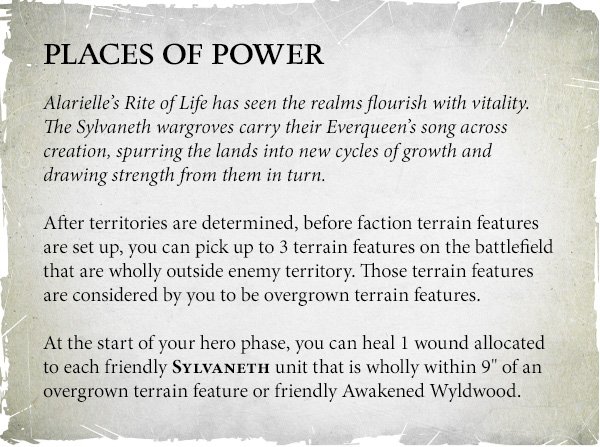
Ironically, one of the rules that most Sylvaneth players probably forget all the time is now your most crucial one. One of the biggest complaints about playing Sylvaneth is the damned Wyldwoods. They’re large, cumbersome to transport and you needed probably at least 3 for a tournament list. This book tried to alleviate some of that pain by allowing you to mark 3 pieces of terrain to make your own forest.
When setup is finished you can pick 3 pieces of terrain that are wholly outside your opponent’s territory. These become Overgrown and function as Wyldwoods for most rules. That means any rule that uses a Awakened Wyldwood, whether it be healing, teleporting, or whatever, you can use your Overgrown territory as well.
This drastically expands the range of board coverage you have for your abilities, and reduces the scenery tax on your wallet. As you’ll see, most of the tools you have to add extra Wyldwoods to the board are still there, so if you want to play tournament games you’ll still wanna bring as many as you can but it does reduce the need for more casual players.
From the Woodland Depths
Two abilities that allow you to use your Awakened Wyldwood (or Overgrown territory) to useful effect. Walk the Hiden Paths this replaces the old Navigate Realmroots rule and is better in basically every way. Instead of being unable to move, this can be used at the end of the movement phase. One unit within 9″ of a Wyldwood or Overgrown Territory can jump to another, ending within 9″ of that terrain piece and more than 9″ of the enemy. There is an additional rule that there must not be an enemy unit within 3″ of it, so if they’re on top of it you’re basically out of luck. Strike and Fade works the same, but after the unit fought in the combat phase meaning if your opponent cant lock you down, you can disappear from any fight that isnt advantageous to you.
Seasons of War
After picking a subfaction, you also get to choose which of the four season the battle will be fought in. Each one offers a bonus whenever you’re wholly within 9″ of a wyldwood or overgrown piece of terrain, in addition to any other rules you may get. Spring (The Burgeoning) is probably the most widely practical and flexible but not necessarily the most powerful. A 6+ Ward will grant you a few extra wounds, especially if you want to run a lot of Monsters like Durthu. Summer (The Reaping) is almost as flexible, and probably a bit more powerful, increasing the range of From the Woodland Depths and the healing from Places of Power by 3″. Fall (The Dwindling) is for casters, granting you 1 reroll on casting, unbinding and dispelling per turn. Finally Winter (Everdusk) reduces the range of your terrain to 6″ instead of 9, but grants exploding 6s to hit on melee attacks. This is huge if you use units with a lot of attacks.
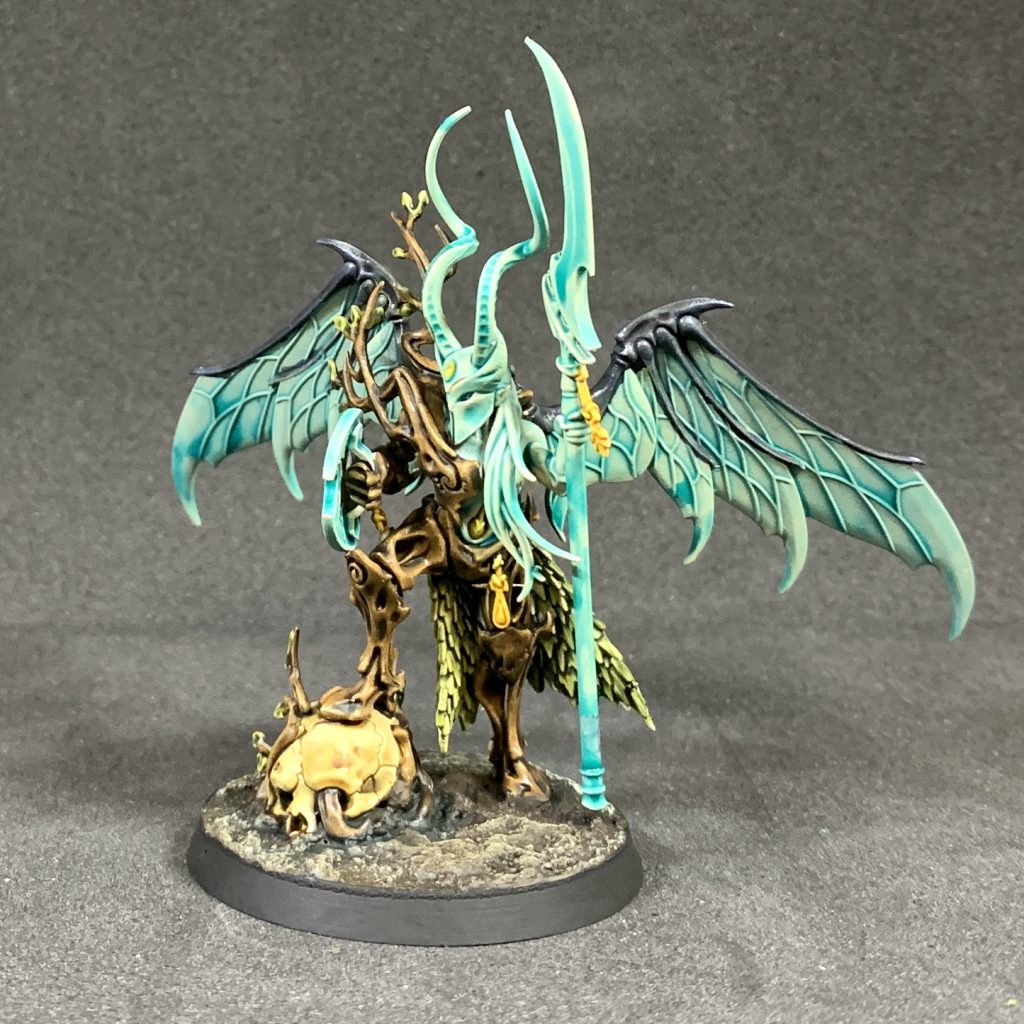
Command Traits
Command traits have two sets of three, one for Wizards and one for everyone and honestly they’re pretty good! First for Wizards, Radiant Spirit returns and is dull, granting just a 4+ ignore spells but the other two get very interesting. The new Nurtured By Magic is solid, healing D3 wounds to a unit within 18″ of the general when they successfully cast a spell once per turn. My favorite though has to be Spellsinger, which previously added 6″ to the range of spells but now lets you measure a spell from an Awakened Wyldwood, anywhere on the board! This grants a ton of versatility. Want to drop a Wyldwood further away than your casting allows? You can do that! Need to buff/debuff a unit just out of range? Pick the Wyldwood. The Sylvaneth rely heavily on their spells and you will get a lot of mileage out of this one
What about everyone else? Gnarled Warrior can come in handy on a Spirit of Durthu, by granting them an unmodifiable save. Similarly Lord of Spites can make the general more hardy as it grants -1 to hit for any enemy unit that finished a pile-in within 3″ of them. The most technical but maybe must useful is Warsinger, as it grants +3″ to movement to all units within 3″. Putting this on Durthu or Spiritsong Revenant will grant you a larger area of coverage and further augment the fairly impressive movement capabilities of the Sylvaneth.
Artefacts
The artefact choices are structured similarly, 3 for wizards and 3 for all.
All 3 wizard relics are definitely interesting. The Acorn of Ages lets you set up 1 free Awakened Wyldwood once per game. I can’t see taking this as you have other ways to spawn one, but it could be powerful if you are short on ways to do it, or are facing an army that will aggressively counter-spell you. Luneth’s Lamp I want to like but is far too niche, as it grants you the ability to Banish an invocation, gaining a +2 on the roll. You’ll be glad you have it when you do but as only 3 armies have invocations, its just not worth it. Finally the Vesperal Gem is going to be a popular take, as once per game you can get an autocast that cannot be unbound. Powerful in the clutch moments you need to get, say Treesong off.
The more generic ones are most aimed at Heroes you expect to get into combat. The Spirit of Durthu, Arch-Revenant and the Warsong Revenant would most benefit from the Greenwood Gladius, which adds D3 attacks (rolled at the start of combat) to the model. The Crown of Fell Bowers gives a bit more leniancy, letting you mark a unit within 6″ at the start of combat and gain +1 to wound rolls against it. You don’t need to get into combat, which lets more supporting heroes make use of it. The Seed of Rebirth is the most flexible, granting a 2+ res to come back with D3 wounds. That’s likely the most practical, as most of your non-named Heroes are quite fragile.
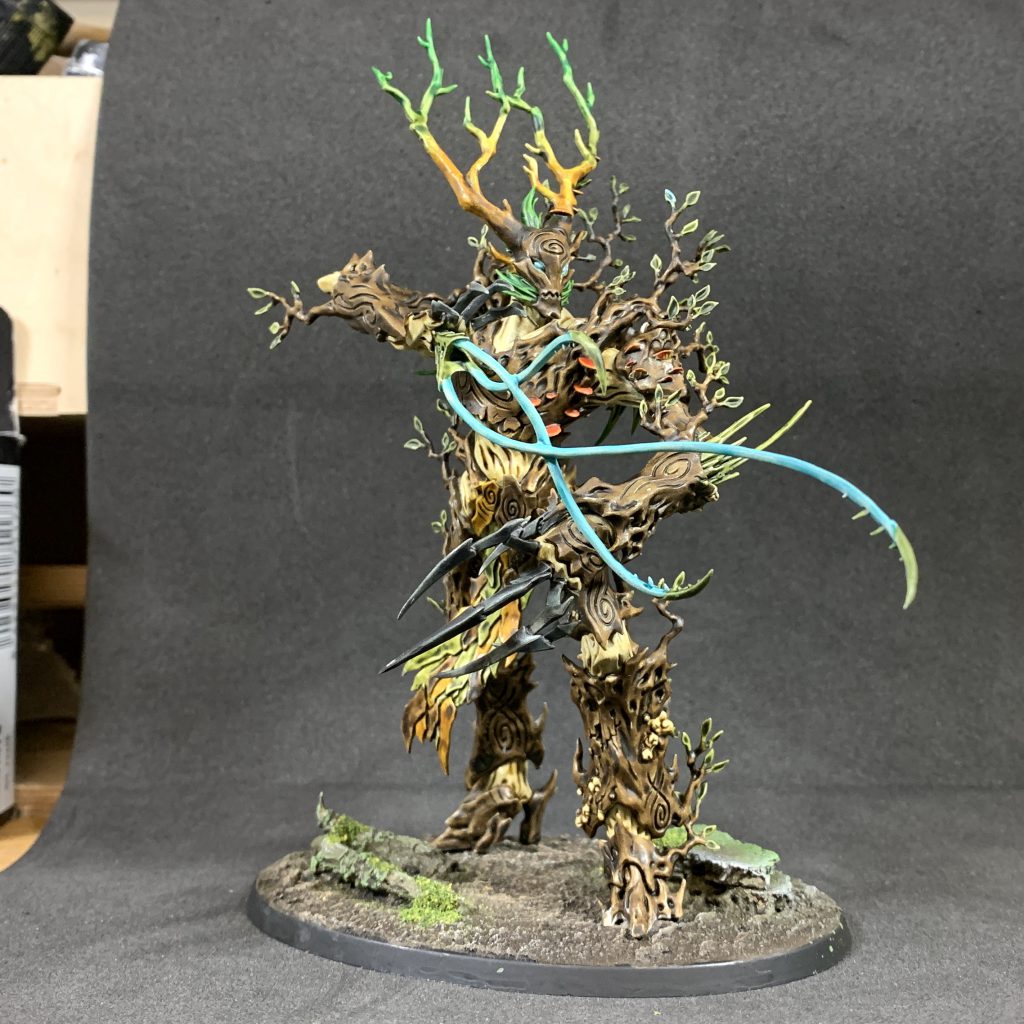
Spells
Just like before, all Wizards have the Verdant Blessing spell in addition to any other spells they have. It allows you to plant an Awakened Wyldwood down, more than 3″ from all other terrain, units, endless spells etc. This isn’t as necessary as before now that Places of Power works but if you have the trees you might as well try and be putting it down every turn while you can.
Other than that you got one lore to draw from, and it’s a solid lore, but not all great. First lets look at the bad news. Throne of Vines used to be a go-to spell, granting +2 to casting, now it heals 1 wound to the caster per phase, not bad but your time is better spent elsewhere. After that it improves, Verdurous Harmony lets you return a model to a unit that lost one, or D3 to your smaller infantry while Regrowth is for healing up your bigger stuff, healing D6 wounds.
On the Offense you get 2 flavors of Mortal Wound spells, The Dwellers Below is your standard horde clearing “roll a die for each model” spell, on a 5+ which is pretty nice. If your army has a neat little castle formed, and you feel confident charging in cast Deadly Harvest which deals D3 mortals to every unit within 3″.
Finally, probably the most important buff spell is Treesong, which allows you to select an Awakened Wyldwood and then gain -1 rend on all units wholly within 9″ of it. Strong stuff if you have the board control to use it right.
The Subfactions (Glades)
If you like your lists large and in charge, Oakenbrow is for you. All Monsters (except Alarielle, unfortunately) count as taking half the damage they did when checking their brackets. This means Durthu needs to take 13 wounds before he loses his Damage 6 sword – so your opponent basically has to kill him. The monsters in Sylvaneth actually are quite good, and kept the faction afloat through the tough times of 3.0. Fielding a Monster heavy list may not be as good as it was in the new GHB but it’s going to do a lot of damage if you take this route. Fittingly, Treelords become battleline in here as well.
For casters we have Gnarlroot, once per turn when casting or unbinding, a Wizard within 9″ of a Wyldwood or Overgrown terrain can roll 3D6 and drop the lowest. Not bad but not sure I’d want to build a whole faction around it with some of the other options on display.
Heartwood is a solid general use bonus. Pick 3 enemy units, gain +1 to attack against them. Not a bad pick, saving resources from All Out Attack for other things. They also gain all the Kurnoth Hunters as battleline, if you wanted to rock a list of those guys.
Ironbark is for those who want to make a strong counter-charge. You gain a unique command ability in your opponent’s combat phase that deals D3 mortals to a unit that is in combat with one of your own. What makes this particularly useful is you can use it multiple times, but you can’t target the same unit. In order to get real returns on this you need to get lucky with rolls, which limits its practicality but it might dissuade smaller units from trying a charge.
For you control players, Winterleaf is potent. Enemies cannot retreat when within combat of one of your units, and if you chose Everdusk as your season of war they cannot teleport either! That is probably good enough on its own to choose Everdusk, as teleports are just common enough to be an issue when you encounter them. Shut that down now.
Dreadwood is odd, once per battle you an use Walk the Hidden Paths and Strike And Fade twice in a row (each one can be used twice) but one of the selected units must be Spite-Revenants. They are no longer stock battleline so if you do want them to become battleline and with their new warscroll you might just wanna pack a few in anyway.
Finally, Harvestboon is for those who love those new dragonflies. They both become battleline in the army and gain a 12″ pre-game move. I’m not sure they need it, given how fast they move, but it certainly can help guarantee that turn 1 charge if you want it.
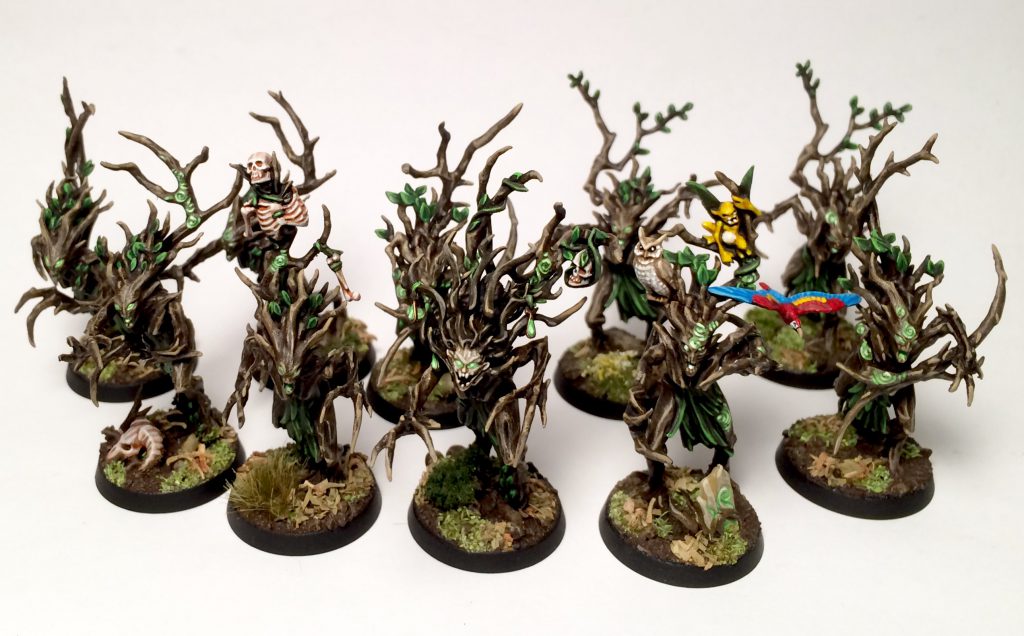
Grand Strategies
This is the first battletome where I get to carry a bit of optimism about the grand strategies, since the General’s Handbook which came out today has increased the difficulty of even the default ones, so for once book Grand Strats are going to look a lot more appealing. First we got Chorus of the Woodlands which steals a Grand Strategy from the Fyreslayers, but asks you to do 4 battle tactics from the battletome instead of 5. Unlike Fyreslayers these aren’t going to be very easy to pull off, and 2 may just be impossible depending on your list.
Vengeance and Spite asks you to kill the enemy general with a unit with the Outcasts keyword, which is an odd choice. This basically boils it down to Drycha or Spite-Revenants. Possible, unless your opponent’s warlord is say a Great Unclean One, then it becomes much more difficult.
The final one can be easy or very hard. The Roots of Victory has two parts, first get an Awakened Wyldwood in each quarter of the field. Very easy to do, you have a ton of ways to get Wyldwoods on the field, you just need to be liberal with them. The second half is keeping enemy units more than 6″ away from them, which is much harder. If you can, stick them in a corner, far from objectives so your opponent has to dedicate resources to thwarting you.
Battle Tactics
You get 5 battle tactics rather than the usual 6, and remember one of the grand strategies is to pull of four of these so keep that in mind if you want to go down that route.
Eradicate Trespassers – Pick an enemy unit within 6″ of an Awakened Wyldwood and kill it by the end of the turn. Simple, you’re probably going to do this as a matter of course over the game, as your opponent attempts to shut down your teleportation with chaff.
Harness the Spirit Paths – Simply teleport using Woodland Depths and successfully charge. Very easy to pull off, again something you’re likely to just do over the course of the game.
Balance the Cycle – Pick an enemy unit within 12″ of and kill them that turn with a summoned unit. Now it’s getting more difficult. Your two options for summoning are some Dryads from the Lady of Vines or a host of options from Alarielle, which means you’re probably going to need to rely on Alarielle here, send a tree lord in and mess some guys up. Doable, but requires setup.
March of the Forest Lands – Kill a Monster with one of your trees, if your opponent has a monster and you have a Spirit of Durthu this is probably a slam dunk, he can cleave through many monsters easily, weaken it a bit first if you have to.
Unleash Ghyran’s Wrath – Basically, kill an enemy with a spell or an endless spell. I reccomend hitting it with Arcane Bolt when it only has one wound, anything else is probably too risky as you just do not have many damage options for spells.
Core Battalions
1 new core battalion if you decide to do the Oakenbrow Monster Mash. You need 2 Treelord ancients and 1 Treelord and you get 1 bonus command point once per game. Not terrible, but 2 Treelord Ancients is pretty pricy, probably a pass on this one.

Units
Leaders
Pour one out for the Branchwraith which is gone and good riddance to that ugly finecast debacle. If you lament it’s loss, treat it as a Branchwych.
Poor Alarielle has never quite gotten to a good place. I always maintained that she wasn’t bad she just cost too much. For an army with pretty weak options, she wasn’t the worst thing you could take. Well, with her score bumped up to 840 and almost no changes to her warscroll I think she finally hit the point of being too expensive to consider. The only change is a resurrection mechanic – something she really did need – which revives her on a 6+, adding a bonus to the die roll based on the battle round. Without a ward, 16 wounds is going to evaporate pretty fast if your opponent has good shooting, and then you have to trust a single 5+ roll to bail her out. She’s going to need to come down in cost or at least get a 6+ ward. Alarielle strikes out again.
Drycha returns and her changes are interesting. She no longer brackets, everything that was tied to the bracket is now locked at the average, which is plenty fine. Her damage came from her Colony of Flitterfuries and Swarm of Squirmlings anyway, and those actually gained a rend. So combined with their mortal wounds on 6s, she can actually dish out some impressive damage. Rounding it out is the Song of Spite which now gives +1 to Spite-Revenants instead of rerolling wounds, and now you might actually want to use those.
The Warsong Revenant is basically the same, which probably isn’t surprising given how new he is. Games Workshop did take one bit of feedback, he had a falchion on his model but no profile! So now he does, its worse than the vines in every way, but you get both so look at it as a few free attacks.
Arch-Revenant saw some reshuffling mostly for the better. First off, you no longer need to kill his little friend to get a guaranteed ward, he survives as long as his master does. As a result I think they may have pulled back a bit too much on his combat stats, since they assume it will always be there. The glaive now gets 4 attacks but Damage 1, but the Zephysprite gets D3 attacks at 2 damage. It probably mostly balances out, not a huge loss as the change to his Crescent Shield more than makes up for it. Now it’s a 4+ ward if you fight defensively instead of just +1 to save, which is absolutely bonkers when he also got an additional wound. He’s a pretty capable fighter now. Naturally his reroll 1s for Kurnoth hunters wound rolls is now a +1 instead of rerolls, which is an acceptable change.
The Treelord Ancient is a bit more buff in combat, with its staff now at 2 attacks for a flat 3 damage instead of 1 at D6 and capping out at 5 Sweeping Blows instead of 3. Its abilities took a bit of pruning, Groundshaker is a monstrous rampage now, just like Durthu and Spirit Path now includes Overgrown terrain. Heed the Spirit-song has been removed byt Awakening the Wood got a huge power increase – its range is now anywhere on the board instead of just 18″. Huge.
Finally, the Branchwych. She lost her bonus attacks when wounded, which is fine since at a 5+ save with 5 wounds, her getting wounded was generally a bad time. Instead she got an extra attack with her scythe. Doesn’t matter, keep her out of combat. She is your discount caster and that’s it.
Lady of Vines and Spirit of Durthu recently appeared in a box set so of course they have not changed, other . Surprisingly they did drop the Lady of Vines 15 points and Durthu 5, making them a slightly more competitive option.
Battleline
You got two base battleline, Dryads and Tree-Revenants. Yes Spite-Revenants are no longer stock battleline, an odd choice, but we’ll get to them later. Dryads have been massively streamlined, the only benefit they get now is -1 to be hit near Awakened Wyldwoods and Overgrown Terrain. They only went up 5 points, which compared to everyone else is effectively a cost reduction, at least. Tree-Revenants meanwhile got a massive glow up. They each have 2 wounds now, and instead of rerolling only one die when attacking or defending they can get All Out Attack or All Out Defense without burning the Command Point! They’ve effectively shifted from the cheap disposable chaff battleline to the more elite one.
Both have their roles, use Dryads if you want cheap bodies on the point, and Tree-Revenants to actually do some damage.
Behemoth
The lone Behemoth who isn’t a leader, the Treelord. Unlike most of his buddies, gotta say he’s taken a bit of a downgrade. His attacks were evened out more so he doesn’t drop off immediately upon taking damage much like Durthu, but his max damage is really hampered. What really holds him back is he no longer does Mortal wounds on 6s, he stops piles in. Which is really good, but it’s not Mortal Wounds on 6s. Still, he may be worth taking as a control piece, to keep dangerous units stuff further back.
Other
Let’s focus on the two new units everyone is excited about, the dragonfly riders: Spiterider Lancers and Revenant Seekers. Both share the same ability: Thrumming with Life which removes all wounds from the unit if they killed an enemy model this turn. Spiterider Lancers are more aggressive, they move a bit faster, gain first strike on the charge while Seekers are more support units. They’re still solid in combat, but can restore a model to a unit who’s wounds are less than 5 wholly within 12″ at the end of movement on a 2+. Essential if you wanna run some Kurnoth Hunters.
Speaking of Kurnoth Hunters let’s look at them, they’ve fallen on hard times since 3.0 removes their reroll saves for planting their roots, so what have they got now? All 3 versions got an updated version of Envoys of the Everqueen which allowed orders to be issued from them, which became redundant in 3rd now that Champions can issue orders. Now they function as mobile overgrown territory for anyone wholly within 6″, much better. Trample Underfoot remains, dealing a mortal wound on a 4 up at the end of combat for each model in this unit. The two melee variants each get their own unique ability, Great Swords Sundering Strikes now does 2 morta wounds on 6s instead of 1, while scythes Tanglethorn Thicket (which is no longer a defense ability and exclusive to the scythes) deal 1 mortal wound when the enemy piles in. Overall the Scythes are probably the way to go for melee, because they are Rend -3 and Damage 2, with 3 attacks per model. It’s going to be the most consistent damage output and absolutely shred through most things.
Next up, the Spite-Revenant. What did they do to get kicked out of battleline status? They gained a second wound like their Tree-Revenant cousins and instead of forcing a reroll of Battleshock tests they now do mortal wounds on 6s, with the average unit doing 16 attacks that’s almost 3 mortals before reinforcement, allowing them to punch well above their weight class. It’s not showy but at only 105 points for 5 it’s a decently cheap source of mortal wound output, especially if you play Dreadwood.
Finally, we already saw the Gossamid Archers in the recent box set. They received a 5 point increase but are naturally preserved. They wont do much damage but make fantastic screens, with their ability to Unleash Hell and then fall back on a 2+, making charging them basically a waste of time
Endless Spells
All 3 endless spells are the same as before. Spiteswarm Hive changed a bit as the defensive buff is now a flat +1 to save instead of reducing rend, making it slightly better. The cost went down on the more expensive ones but they generally weren’t worth taking before so who is to say if that will change.
Conclusion
This book is solid. The core idea of Sylvaneth was always good, it just never had the right units or rules to support it. I think this takes what Sylvaneth are supposed to be good at, which is being very evasive and maneuverable while also maintaining incredible board control, and makes them much more adept.
Their units are deceptively more fragile, and they still don’t have quite the unit variety as some other armies, but the new rules allow them to duck in and out of the trees while avoiding combat altogether, unless it is on their terms. This gives them an incredibly steep learning curve for beginners but one who is willing to master them will be able to finish a battle pretty much unscathed. For an army that spent so long in the dregs of the bottom tier, this is going to be an exciting time for Sylvaneth players
If you have any questions or comments, leave one below or email us at contact@goonhammer.com.
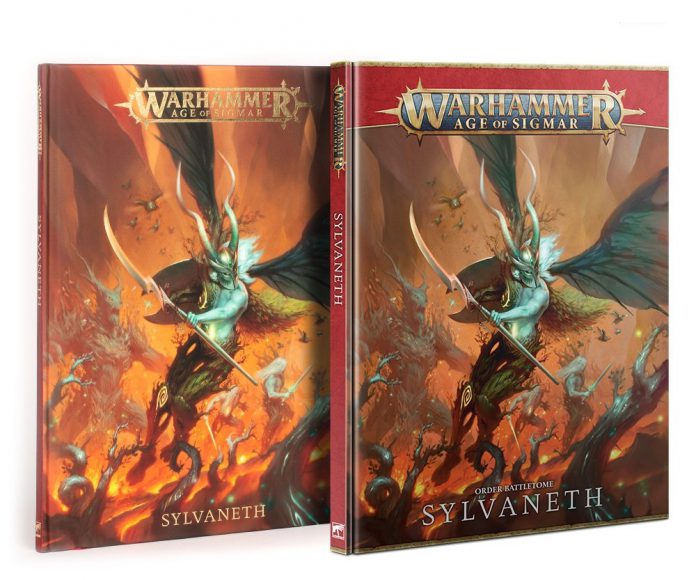


You must be logged in to post a comment.